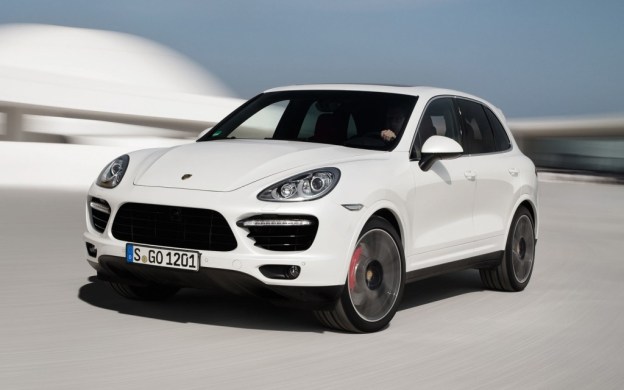 Porsche is continuing to hone its second generation Cayenne lineup with new models. The company recently launched the Cayenne GTS as a sort of middle road between base Cayennes and the high performance Turbo. Now, Porsche is releasing a new top dog: the Cayenne Turbo S.
Porsche is continuing to hone its second generation Cayenne lineup with new models. The company recently launched the Cayenne GTS as a sort of middle road between base Cayennes and the high performance Turbo. Now, Porsche is releasing a new top dog: the Cayenne Turbo S.
As the name implies, the Turbo S is a Cayenne Turbo with a little added spice. This SUV’s 4.8-liter V8 produces 550 horsepower and 553 pound-feet of torque, compared to 500 hp and 516 lb-ft in the Cayenne Turbo. The more powerful engine is hooked to an eight-speed automatic transmission and all-wheel drive.
As a result, the Turbo S beats its predecessor to 60 mph 0.1 seconds and betters its top speed by 3 mph. Those may not sound like significant differences, but they add up to 60 mph in 4.3 seconds and a top speed of 175 mph. We live in a perverted world, one where an SUV has a higher top speed than a BMW M5.
To keep the extra power under control, The Cayenne Turbo S includes many electronic driver aids that are optional on lesser Cayenne models. The acronym parade starts with Porsche Dynamic Chassis Control (PDCC), which actively adjusts the suspension to reduce body roll. Porsche Torque Vectoring Plus (PTV Plus) brakes the inside rear wheel to coax the Turbo S around corners. Finally, Power Steering Plus varies power steering boost based on vehicle speed for better feel.
Visual changes for the Cayenne Turbo S are limited. The most noticeable modifications are 21-inch Turbo II wheels cribbed from the 911, polished aluminum exhaust tips, and some gloss black trim. The interior gets a few carbon fiber trim pieces and an Alcantara headliner.
When it hits U.S. showrooms next spring, the hottest version of Porsche’s SUV will do battle with other super sport-utes, such as the BMW X5 M, Mercedes-Benz ML63 AMG, and Jeep Grand Cherokee SRT8.
Both the X5 and ML63 beat the Cayenne Turbo S in acceleration, with times of 4.0 and 4.2 seconds, respectively. The Grand Cherokee lags behind at a still-quick 5.0 seconds. The Mercedes’ 175 mph top speed ties the Porsche’s; both SUVs leave the BMW (159 mph) and the Jeep (157 mph) in their dust.
The Cayenne and its rivals seem evenly matched, but you wouldn’t know it from looking at their window stickers. The Turbo S costs $146,975, making it the most expensive of Porsche’s seven Cayenne models. It also makes this Porsche significantly more expensive than either of its German rivals: the X5 M costs $88,145, while the ML63 AMG costs $97,005. Despite its (relative) shortcomings, the Grand Cherokee SRT8 looks like an absolute bargain at $61,785.



